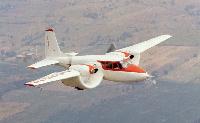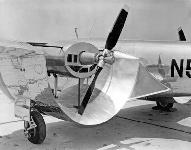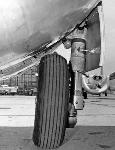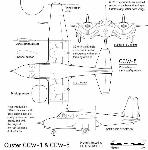
Варианты
- Baumann - B-250 / B-290 Brigadier - 1947 - США
- Custer - CCW-5 - 1953 - США
Фотографии
-
Aviation Historian 16 / N.Stroud - Willard Custer & the Channel Wing
Регистрационный номер: N6257C [2] The prototype five-seater CCW-5, N6257C, up from Custer’s base at Hagerstown Municipal Airport in the summer of 1953, shortly after its maiden flight that July. Modifications were made to the prototype during the test programme, including extending the forward edge of the nacelles and reducing the diameter of their cooling inlets.
-
Aviation Historian 16 / N.Stroud - Willard Custer & the Channel Wing
Регистрационный номер: N6257C [2] Unconventional wisdom - Willard Custer’s peculiar but proven channel-wing concept aircraft, the CCW-5.
-
Aviation Historian 16 / N.Stroud - Willard Custer & the Channel Wing
Регистрационный номер: N5855V [10] Production CCW-5 N5855V comes in for a landing at Hagerstown in 1964. In September that year Kevin Brown, Editor of Popular Mechanics, flew the aircraft: “As the ’plane loses speed, the nose comes up to hold altitude, and power is put back on. It’s like releasing the clutch and applying the accelerator in a stick-shift auto”.
-
Aeroplane Monthly 2000-04 / M.Hiscock - Jungle Widow /In the workshop/
Регистрационный номер: N5855V [10] Unique 1964 Custer CCW-5 Channel Wing N5855V is one off the more unusual exhibits, seen here in front off the museum’s main hangar. N5855V was a STOL aircraft with 250 h.p. Continental engines utilising semi-ducted propellers which drew air through the channels at high velocity to generate extra lift.
-
Jane's All the World Aircraft 1966 / 02 - Aircraft
Регистрационный номер: N5855V [10] First production model of the Custer CCW-5 channel-wing aircraft
-
Aviation Historian 16 / N.Stroud - Willard Custer & the Channel Wing
Регистрационный номер: N5855V [10] The one and only production CCW-5 in its final iteration, with a revised higher position for the tailplane and a taller fin. Along with the CCW-1, this aircraft also survives today and is under long-term restoration at the Mid-Atlantic Air Museum in Reading, Pennsylvania.
-
Aviation Historian 16 / N.Stroud - Willard Custer & the Channel Wing
Регистрационный номер: N5855V [10] The doggedly determined Willard Ray Custer beside the final iteration of the sole production Custer Channel Wing CCW-5 in the mid-1960s.
-
Aviation Historian 16 / N.Stroud - Willard Custer & the Channel Wing
Регистрационный номер: N5855V [10] The starboard channel wing and Continental engine of the first - and only - production CCW-5, N5855V. The channel incorporated a NACA 4418 aerofoil from the root to just outboard of the channel, and the outer wings were of NACA 4412 section.
-
Aviation Historian 16 / N.Stroud - Willard Custer & the Channel Wing
Регистрационный номер: N5855V [10] The rear of the port channel; both channels were more slender on the production example in order to reduce drag. Note how closely the propeller skims the channel’s trailing edge.
-
Aviation Historian 16 / N.Stroud - Willard Custer & the Channel Wing
Регистрационный номер: N5855V [10] The nosewheel retracted forward and was fitted with a Goodyear 6-00 x 6 tyre (6in wide on a 6in-diameter wheel).
-
Aviation Historian 16 / N.Stroud - Willard Custer & the Channel Wing
Регистрационный номер: N5855V [10] The short 6-50 x 10 mainwheels retracted into the outer surfaces of the channels, the wheels being exposed and standing slightly proud of the channels.
-
Aviation Historian 16 / N.Stroud - Willard Custer & the Channel Wing
Регистрационный номер: N5855V [10] The dual-control cockpit of the CCW-5 was laid out conventionally, with no additional controls or instruments.












